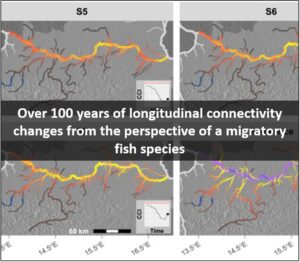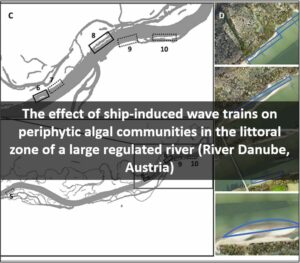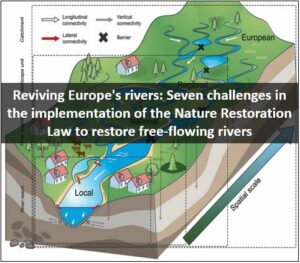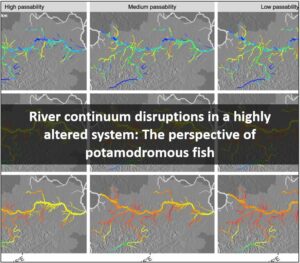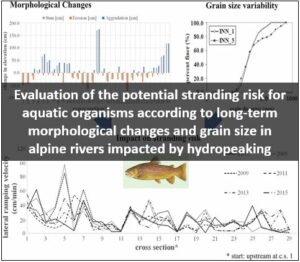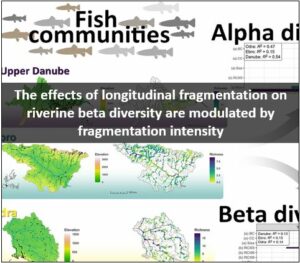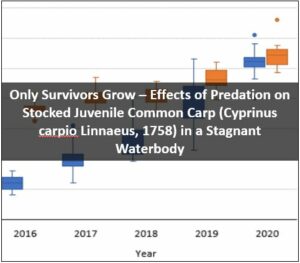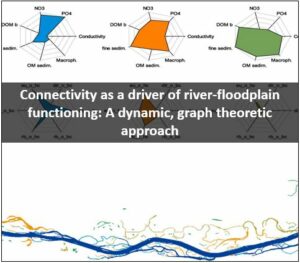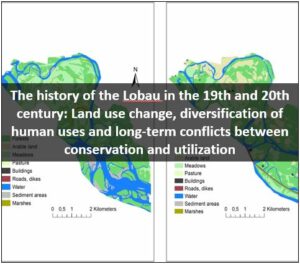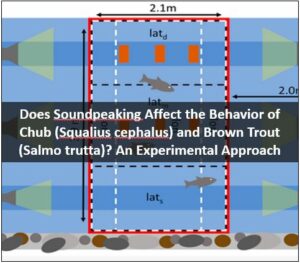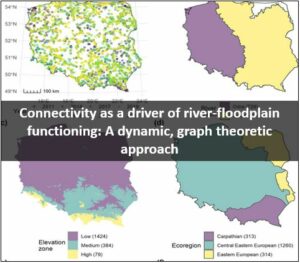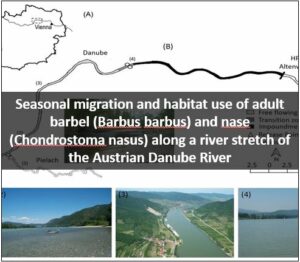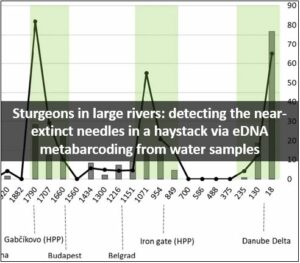Peer Reviewed Publications
2025
Daniel Pelz, Thomas Friedrich, Bernhard Zeiringer, Thomas Hein, Günther Unfer,
Reproductive ecology of three rheophilic fish species in the Austrian Danube River system: Insights into the spawning of Chondrostoma nasus, Barbus barbus, and Vimba vimba, and the larval development of C. nasus in the River Traisen,
Limnologica, Volume 112, 2025
Johannes Luca Kowal, Gertrud Haidvogl, Andrea Funk, Johannes Schützenhofer, Paulo Branco, Maria-Teresa Ferreira, Paul Meulenbroek, Rafaela Schinegger, Thomas Hein, Over 100 years of longitudinal connectivity changes from the perspective of a migratory fish species, Ecological Indicators, Volume 175, 2025
2024
Elisabeth Bondar-Kunze, Anna-Lisa Dittrich, Philipp Gmeiner, Marcel Liedermann, Thomas Hein,
The effect of ship-induced wave trains on periphytic algal communities in the littoral zone of a large regulated river (River Danube, Austria), Science of The Total Environment, Volume 954, 2024
Stoffers, T., Altermatt, F., Baldan, D., Bilous, O., Borgwardt, F., Buijse, A. D., Bondar-Kunze, E., Cid, N., Erős, T., Ferreira, M. T., Funk, A., Haidvogl, G., Hohensinner, S., Kowal, J., Nagelkerke, L. A. J., Neuburg, J., Peller, T., Schmutz, S., Singer, G. A., … Hein, T. (2024). Reviving Europe’s rivers: Seven challenges in the implementation of the Nature Restoration Law to restore free-flowing rivers. WIREs Water, e1717.
Hayes, Daniel & Hauer, Christoph & Unfer, Günther. (2024). Fish stranding in relation to river bar morphology and baseflow magnitude: Combining field surveys and hydrodynamic–numerical modelling. Ecohydrology. 10.1002/eco.2616
Johannes L. Kowal, Andrea Funk, Günther Unfer, Damiano Baldan, Gertrud Haidvogl, Christoph Hauer, Maria T. Ferreira, Paulo Branco, Rafaela Schinegger, Thomas Hein,
River continuum disruptions in a highly altered system: The perspective of potamodromous fish,
Ecological Indicators,
Volume 164,
2024
2023
C. Hauer, L. Schmalfuss, G. Unfer, M. Schletterer, M. Fuhrmann, P. Holzapfel, (2023) Evaluation of the potential stranding risk for aquatic organisms according to long-term morphological changes and grain size in alpine rivers impacted by hydropeaking, Science of The Total Environment,Volume 883.
Baldan D, Cunillera-Montcusí D, Funk A, Piniewski M, Cañedo-Argüelles M, Hein T. The effects of longitudinal fragmentation on riverine beta diversity are modulated by fragmentation intensity. Sci Total Environ. 2023 Sep
Valentin, S., Günther, U., & Thomas, F. (2023). Only Survivors Grow – Effects of Predation on Stocked Juvenile Common Carp (Cyprinus carpio Linnaeus, 1758) in a Stagnant Waterbody. Turkish Journal of Fisheries and Aquatic Sciences, 23.
Funk, Andrea & Baldan, Damiano & Bondar-Kunze, Elisabeth & Recinos, Sonia & Kowal, Johannes & Hein, Thomas. (2023). Connectivity as a driver of river-floodplain functioning: A dynamic, graph theoretic approach. Ecological Indicators 154 (2023)
Haidvogl, G (2023): The history of the Lobau in the 19th and 20th century: Land use change, diversification of human uses and long-term conflicts between conservation and utilization. Acta ZooBot Austria 159, 5-19
Kowal JL, Auer S, Schmutz S, Graf W, Wimmer R, Tonolla D, Meulenbroek P. Does Soundpeaking Affect the Behavior of Chub (Squalius cephalus) and Brown Trout (Salmo trutta)? An Experimental Approach. Fishes. 2023; 8(12):581.
2022
Baldan, D, Chattopadhyay, S, Prus, P, Funk, A, Keller, A, Piniewski, M. (2022) Regionalization strategy affects the determinants of fish community structure. Ecohydrology.
Eder M, Perosa F, Hohensinner S, Tritthart M, Scheuer S, Gelhaus M, Cyffka B, Kiss T, Van Leeuwen B, Tobak Z, Sipos G, Csikós N, Smetanová A, Bokal S, Samu A, Gruber T, Gălie A-C, Moldoveanu M, Mazilu P, Habersack H. How Can We Identify Active, Former, and Potential Floodplains? Methods and Lessons Learned from the Danube River. Water. 2022; 14(15):2295.
Panchan, R. Pinter, K. Schmutz, S. Unfer, G. (2022) Seasonal migration and habitat use of adult barbel (Barbus barbus) and nase (Chondrostoma nasus) along a river stretch of the Austrian Danube River. Environmental Biology of fishes, 105(11), 1601-1616.
Bondar-Kunze, E., Funk, A., Haidvogl, G. et al. Der Meta-Ökosystem Ansatz in der Praxis – Integration von hydromorphologischen Veränderungen und menschlichen Eingriffen in die Meta-Ökosystem-Theorie zur Entwicklung eines nachhaltigen Flussmanagements an der österreichischen Donau. Österr Wasser- und Abfallw 74, 501–509 (2022).
Hohensinner, S., Grupe, S., Klasz, G., & Payer, T. (2022). Long-term deposition of fine sediments in Vienna’s Danube floodplain before and after channelization. Geomorphology, 398, 108038.
Damiano Baldan, David Cunillera-Montcusí, Andrea Funk, Thomas Hein, Introducing ‘riverconn’: an R package to assess river connectivity indices, Environmental Modelling & Software, Volume 156, 2022, 105470, ISSN 1364-8152.
Meulenbroek, P., Hein, T., Friedrich, T. et al. (2022). Sturgeons in large rivers: detecting the near-extinct needles in a haystack via eDNA metabarcoding from water samples.
Biodivers Conserv 31, 2817–2832.
Christian Doppler Research Association
The Christian Doppler Research Association promotes the cooperation between science and business. Specifically, this takes place in specially established research units with fixed terms, in which application-orientated basic research is pursued: Christian Doppler Laboratories at universities and non-university research institutions, Josef Ressel Centres at universities of applied sciences.
Under the direction of highly qualified scientists, research groups work in close contact with the commercial partners on innovative responses to business-related research issues.


